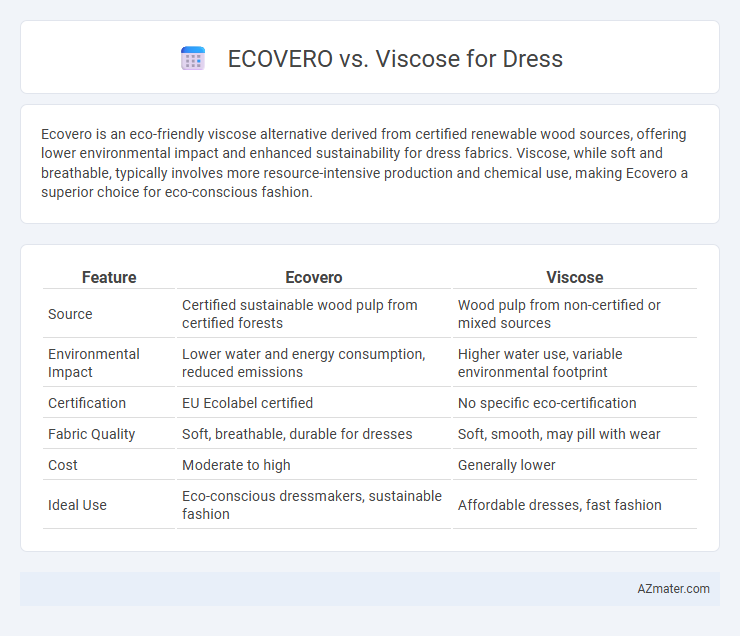Ecovero is an eco-friendly viscose alternative derived from certified renewable wood sources, offering lower environmental impact and enhanced sustainability for dress fabrics. Viscose, while soft and breathable, typically involves more resource-intensive production and chemical use, making Ecovero a superior choice for eco-conscious fashion.
Table of Comparison
| Feature | Ecovero | Viscose |
|---|---|---|
| Source | Certified sustainable wood pulp from certified forests | Wood pulp from non-certified or mixed sources |
| Environmental Impact | Lower water and energy consumption, reduced emissions | Higher water use, variable environmental footprint |
| Certification | EU Ecolabel certified | No specific eco-certification |
| Fabric Quality | Soft, breathable, durable for dresses | Soft, smooth, may pill with wear |
| Cost | Moderate to high | Generally lower |
| Ideal Use | Eco-conscious dressmakers, sustainable fashion | Affordable dresses, fast fashion |
Introduction to Ecovero and Viscose
Ecovero is an eco-friendly, sustainable fabric made from certified renewable wood sources with a significantly lower environmental impact than traditional viscose. Viscose, a widely used semi-synthetic fiber derived from wood pulp, offers soft texture and breathability but often involves resource-intensive and pollutive manufacturing processes. Choosing Ecovero over standard viscose supports sustainable fashion by reducing water usage, greenhouse gas emissions, and chemical discharge during production.
Fiber Origins and Production Processes
Ecovero fibers are derived from sustainably sourced wood pulp certified by the Forest Stewardship Council (FSC), ensuring environmentally responsible forestry practices. Viscose is made from wood pulp as well but often involves conventional, chemically intensive processing that can harm ecosystems. Ecovero's production process uses up to 50% less water and energy than generic viscose, reducing emissions and wastewater pollutants significantly.
Environmental Impact Comparison
Ecovero fibers, derived from certified sustainable wood sources, offer a significantly lower environmental footprint compared to traditional viscose, reducing CO2 emissions by up to 50% and consuming less water during production. Viscose production involves intensive chemical processes and deforestation risks, contributing to habitat destruction and higher pollution levels. Choosing Ecovero for dresses supports eco-friendly fashion through responsible sourcing and reduced ecological impact without compromising fabric quality.
Softness and Comfort for Dresses
Ecovero fabric offers superior softness and breathability compared to traditional viscose, enhancing comfort for dresses worn during long hours. Its eco-friendly production process results in a gentle texture that feels smooth against the skin, reducing irritation often associated with conventional viscose fibers. Dresses made from Ecovero maintain a lightweight drape and moisture-wicking properties, making them a preferred choice for comfortable, stylish wear.
Breathability and Moisture Management
Ecovero fabric, derived from sustainably sourced wood pulp, offers superior breathability compared to traditional viscose, making it ideal for dresses worn in warm climates or active settings. Its advanced moisture management properties wick sweat away from the skin efficiently, keeping the wearer cool and dry throughout the day. Viscose, while smooth and lightweight, tends to retain moisture longer, which can reduce overall comfort in humid or high-activity conditions.
Durability and Longevity
Ecovero fabric offers enhanced durability and longevity compared to traditional viscose due to its sustainable production process that maintains fiber strength while reducing chemical use. Viscose, though soft and breathable, tends to weaken with repeated washing and wear, leading to faster fabric degradation. Choosing Ecovero ensures a more resilient dress material that withstands frequent use without compromising environmental responsibility.
Color Vibrancy and Dye Retention
Ecovero fabric, derived from sustainable wood pulp, offers superior color vibrancy and excellent dye retention compared to traditional viscose, ensuring dresses maintain their bright hues after multiple washes. Viscose tends to lose color intensity more quickly due to its less stable fiber structure, resulting in faster fading and dullness over time. Manufacturers prefer Ecovero for eco-friendly dresses that demand long-lasting, vivid colors and enhanced fabric durability.
Price and Accessibility
Ecovero fibers, derived from sustainably managed wood sources, typically come at a higher price point compared to conventional viscose due to eco-friendly production processes. Viscose is widely accessible and found in a vast range of dress fabrics globally, making it a more affordable and readily available option. Consumers seeking sustainable dress materials may choose Ecovero despite its premium cost, reflecting growing demand for environmentally conscious textiles.
Care Instructions and Maintenance
Ecovero fabrics require gentle machine washing at low temperatures, avoiding bleach to preserve their eco-friendly fibers and vibrant colors. Viscose dresses need hand washing or delicate machine cycles with cold water, as the material is prone to shrinking and losing shape when exposed to heat. Both fabrics benefit from air drying and ironing on low heat to maintain fabric integrity and appearance over time.
Which Fabric is Best for Dresses?
Ecovero, an eco-friendly viscose variant certified for sustainable production, offers superior breathability and softness, making it ideal for comfortable, stylish dresses. Viscose provides a smooth texture and vibrant drape but may involve environmentally harmful manufacturing processes. Choosing Ecovero ensures a sustainable fabric option without compromising the luxurious feel required for high-quality dress materials.

Infographic: Ecovero vs Viscose for Dress
 azmater.com
azmater.com